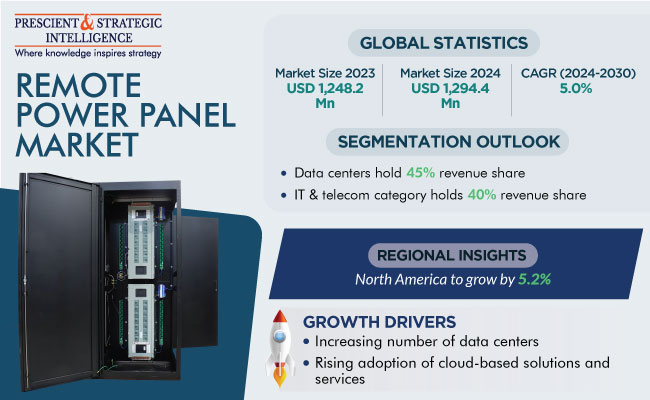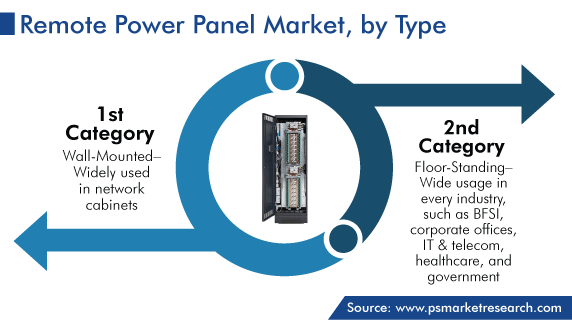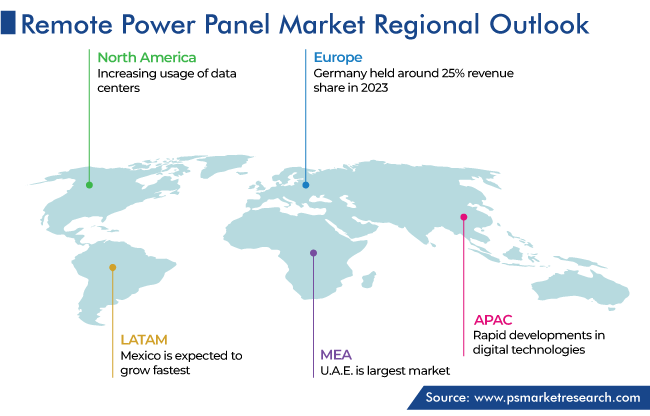Report Code: 12852 | Available Format: PDF | Pages: 210
Remote Power Panel Market Size and Share Analysis by Type (Wall-Mounted, Floor-Standing), Application (Data centers, Network Cabinets, Server Rooms), End User (BFSI, IT & Telecom, Healthcare, Government & Defense) - Global Industry Revenue Estimation and Demand Forecast to 2030
- Report Code: 12852
- Available Format: PDF
- Pages: 210
- Report Description
- Table of Contents
- Market Segmentation
- Request Free Sample
Market Overview
The global remote power panel market generated an estimated USD 1,248.2 million revenue in 2023, and it is projected to witness a CAGR of 5.0% during 2024–2030, reaching USD 1,734.7 million by 2030. This is attributed to the increasing number of data centers and corporate offices with the rising level of urbanization across the globe. Remote power panels are majorly used in data centers because they provide local power directly to server racks, with more control.
Hence, to capitalize on the growing demand for them, companies are launching variants with unique designs for data centers. For instance, in September 2021, Vertiv Group Corporation announced two new power distribution systems—Liebert RXA remote power panel and Liebert MBX busway system—for high-density power in data centers. Further, in August 2020, Schneider Electric SE launched the new Galaxy remote power panel for expanding high-density power distribution capacity in data centers and colocation facilities.

Further, in 2022, various data centers were under construction around the world, thus driving the demand for all kinds of associated products and services, such as engineering, procurement, and construction (EPC) services, IT hardware, and cooling and power supply apparatus.
Moreover, COVID-19 positively influenced the market due to the exponential increase in the demand for online communication with the implementation of the work-from-home model by various organizations. People were forced to interact with each other online, and data centers supported the resulting increase in internet traffic and allowed employees to continue to collaborate and business to keep their data secured. According to a study, between 2019 and 2020, international internet capacity grew by 35%, from around 450 Tbps to over 600 Tbps.
Floor-Standing Variants Hold Larger Share in Market
The floor-standing category accounts for the larger share, of 65%, in the market. This is attributed to the large space available for floor-standing variants and their wide usage in every industry, such as BFSI, corporate offices, IT & telecom, healthcare, and government. These power panels are crucial for industrial automation as they give better control over the production machinery, thus allowing manufacturers to define, organize, and meet production objectives.
The wall-mounted category also generates significant revenue in the market. This is because these variants are small and thus, take less space and are widely used in network cabinets. Moreover, their lower cost than other variants make them popular across industries.

Exponential Growth in Data Generation Is Biggest Market Driver
The increasing number and size of databases are facilitating the growth of companies, by allowing for improved decision making, as they allow organizations to analyze past trends and adjust their plans for the future. Companies gather data to enhance their offerings, maintain client relationships, and boost revenue. Businesses need to be prepared to handle the constantly expanding volumes of data in order to do this.
Moreover, billions of people around the world use the internet, and every online activity produces data. Companies in all sectors want to use it to manage human resources, track goods from production to delivery, and gather customer data. It is estimated that around 328 million Terabytes of data are produced every day. In addition, 70% of the data in the entire digital universe is currently user-generated. It is expected that by the end of 2028, the healthcare sector may spend around USD 80 billion on big data analytics. This will boost the market growth by augmenting the need for having computer servers in continuous operation.
Data generation plays a significant role in driving the remote power panel market as reliable and efficient power management solutions is necessary to support the increasing demand for data processing and storage in remote locations. Moreover, the increasing deployment of off-grid renewable energy systems and the rising demand for remote monitoring and control capabilities in various industries are propelling the market growth.
Data Centers Account for Largest Share in Market
By application, data centers dominate the market, owing to the increasing number of such establishments around the world. The increasing pace of 5G network deployment is leading to the increasing data usage and, subsequently, driving the demand for the associated infrastructure, most importantly data centers.
Server rooms also hold a significant share in the market as these spaces provide a central point for organizations to manage their network server resources. Remote power panels provide power distribution extensions from the electricity source directly to server racks, with several benefits, including a high distribution capacity and reduced cooling need. Essentially, the growing internet usage is driving the number of servers, which, in turn, is propelling the need for effective electricity distribution in server rooms.
IT & Telecom Category Holds Largest Share
The IT & telecom category dominates the remote power panel market with a share of 40%. This is due to the increasing online shopping activities, which result in the generation of massive volumes of customer data. In addition, companies in the IT & telecom sector need data centers to provide fast and reliable communication services to customers. Here, remote power panels enable efficient management and control of power distribution, allow for remote monitoring and troubleshooting, reduce the need for on-site interventions, improve energy efficiency, and enhance the overall reliability of the data center’s power infrastructure.
Rise in Adoption of Cloud-Based Solutions and Services
Cloud-based platforms, including Microsoft Azure, Amazon Web Services (AWS), and Google Cloud, benefit companies as well as individuals with their self-service and pay-per-use features, energy savings, storage scale up and scale down ability based on usage, data security, high resilience, access to various computing resources at a low cost. All these benefits lead to much lower IT costs, less time to market, and a better service quality compared to the traditional, on-premises IT offerings.
The adoption of cloud-based solutions shows a shift in businesses’ approach toward the IT infrastructure. Essentially, the scalability provided by cloud services drives their popularity among companies. Users can effortlessly scale their computing resources up or down based on demand, ensuring optimal performance without the need for a substantial upfront investment in hardware. This flexibility proves invaluable in dynamic business environments, where fluctuating workloads are common.
Cost-effectiveness is another factor propelling the surge in cloud adoption. Organizations can replace their capital-investment IT expenditure with a pay-as-pay-go model, only paying for the resources they consume. This not only reduces initial costs but also allows for more-predictable budgeting.
Accessibility also plays a crucial role, with cloud solutions enabling users to access data and applications from virtually anywhere, with an internet connection. This has become increasingly important with the rise of remote working models, where the ability to collaborate seamlessly and stay productive regardless of the location is prized among companies and employees alike.
Furthermore, offloading infrastructure management to cloud service providers streamlines operations for businesses. It allows them to focus on their core competencies, while relying on experts to handle the intricacies of maintaining and securing the underlying IT infrastructure. As the cloud technology continues to mature and address security concerns, its adoption is poised to persist, thus modernizing and optimizing IT landscape.
Further, according to industry leaders, companies that use cloud-based solutions enjoy more-efficient workflows than those that have not. Since data centers house the necessary technology to provide cloud services, an increase in the demand for cloud-based solutions results in an increase in the need for data centers.
| Report Attribute | Details |
Market Size in 2023 |
USD 1,248.2 Million |
Market Size in 2024 |
USD 1,294.4 Million |
Revenue Forecast in 2030 |
USD 1,734.7 million |
Growth Rate |
5.0% CAGR |
Historical Years |
2017-2023 |
Forecast Years |
2024-2030 |
Report Scope |
Market Trends, Drivers, and Restraints; Revenue Estimation and Forecast; Segmentation Analysis; Impact of COVID-19; Companies’ Strategic Developments; Market Share Analysis of Key Players; Company Profiling |
Segments Covered |
By Type; By Application; By End User; By Region |
Explore more about this report - Request free sample
North America Is Highest Revenue Contributor to Market
Geographically, North America accounts for the largest share in the market, and it is expected to grow at a CAGR of 5.2% during the forecast period. This is attributed to the increasing usage of data centers and IoT technologies, growing IT & telecom industry, and presence of key cloud service providers in this region. In addition, North America is a technologically advanced region with a robust industrial base and therefore, has a large number of colocation facilities and data center clusters offering related services.

Some of Key Players in Remote Power Panel Market Are:
- ABB Ltd.
- Hanley Energy Limited
- Schneider Electric SE
- Toshiba International Corporation
- SOCOMEC
- Anord Mardix
- Lyntec
- LayerZero Power Systems Inc.
- The EA Group
- Raptor Power Systems
Report Breakdown
This report offers deep insights into the remote power panel market, with size estimation for 2017 to 2030, the major drivers, restraints, trends and opportunities, and competitor analysis.
Segmentation Analysis by Panel Type
- Wall-Mounted
- Floor-Standing
Segmentation Analysis by Applications of Panels
- Data centers
- Network Cabinets
- Server Rooms
Segmentation Analysis by End User
- BFSI
- IT & Telecom
- Healthcare
- Government & Defense
Region/Countries Analyzed
- North America
- U.S.
- Canada
- Europe
- Germany
- U.K.
- France
- Italy
- Spain
- Asia-Pacific
- Japan
- China
- India
- South Korea
- Australia
- Latin America
- Brazil
- Mexico
- Middle East and Africa
- Saudi Arabia
- South Africa
- U.A.E.
The market for remote power panels has a CAGR of 5.0%.
The remote power panel industry will reach USD 1,734.7 million by 2030.
The market for remote power panels is driven by the rise in data generation and usage.
The COVID-19 pandemic impacted the remote power panel industry positively.
The floor-standing bifurcation dominates the market for remote power panels.
The IT & telecom category holds the biggest remote power panel industry share, by end user.
North America generates the highest revenue, and APAC is the fastest-growing market for remote power panels.
Want a report tailored exactly to your business strategy?
Request CustomizationWant an insight-rich discussion with the report author?
Speak to AnalystOur dedication to providing the most-accurate market information has earned us verification by Dun & Bradstreet (D&B). We strive for quality checking of the highest level to enable data-driven decision making for you
Our insights into the minutest levels of the markets, including the latest trends and competitive landscape, give you all the answers you need to take your business to new heights
With 24/7 research support, we ensure that the wheels of your business never stop turning. Don’t let time stand in your way. Get all your queries answered with a simple phone call or email, as and when required
We take a cautious approach to protecting your personal and confidential information. Trust is the strongest bond that connects us and our clients, and trust we build by complying with all international and domestic data protection and privacy laws